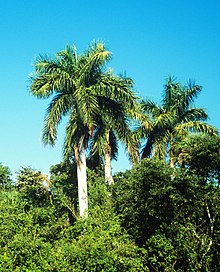| Royal palm | |
|---|---|

| |
| Native habitat in Collier-Seminole State Park, Florida | |
| Scientific classification | |
| Kingdom: | Plantae |
| Clade: | Tracheophytes |
| Clade: | Angiosperms |
| Clade: | Monocots |
| Clade: | Commelinids |
| Order: | Arecales |
| Family: | Arecaceae |
| Genus: | Roystonea |
| Species: | R. regia
|
| Binomial name | |
| Roystonea regia | |

| |
| Natural range of Roystonea regia | |
| Synonyms[3] | |
|
Oreodoxa regia Kunth | |
Roystonea regia, commonly known as the royal palm, Cuban royal palm, or Florida royal palm,[4] is a species of palm native to Mexico, the Caribbean, Florida, and parts of Central America. A large and attractive palm, it has been planted throughout the tropics and subtropics as an ornamental tree. Although it is sometimes called R. elata, the conserved name R. regia is now the correct name for the species. The royal palm reaches heights from 15–24 m (50–80 ft) tall.[5] Populations in Cuba and Florida were long seen as separate species, but are now considered a single species.
Widely planted as an ornamental, R. regia is also used for thatch, construction timber, and in some forms of traditional medicine, although there is currently no valid scientific evidence to support the efficacy or use of any palm species for medicinal purposes. The fruit is eaten by birds and bats (which disperse the seeds) and fed to livestock. Its flowers are visited by birds and bats, and it serves as a roosting site and food source for a variety of animals. Roystonea regia is the national tree of Cuba,[6] and has a religious role both in Santería and Christianity, where it is used in Palm Sunday observances.
- ^ Carrero, C. (2021). "Roystonea regia". IUCN Red List of Threatened Species. 2021: e.T62329A59233195. doi:10.2305/IUCN.UK.2021-1.RLTS.T62329A59233195.en. Retrieved 19 November 2021.
- ^ "NatureServe Explorer 2.0".
- ^ "Roystonea regia". Royal Botanic Gardens, Kew: World Checklist of Selected Plant Families. Archived from the original on 2013-09-22. Retrieved 2009-01-03.
- ^ "Roystonea regia". Germplasm Resources Information Network. Agricultural Research Service, United States Department of Agriculture. Retrieved 6 May 2021.
- ^ "Tree Register: National Register of Big Trees". Retrieved 2019-05-12.
- ^ "Cuban Royal Palm (Roystonea regia), national tree of Cuba". Cuba Naturaleza. Archived from the original on 2020-07-27. Retrieved 2009-04-21.

